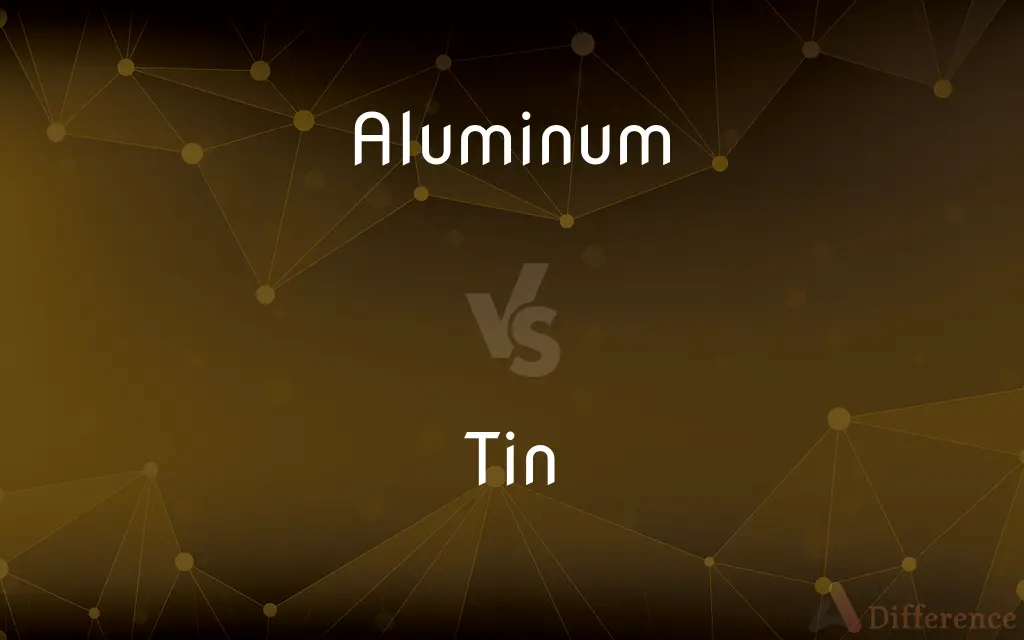Aluminum vs. Tin — What's the Difference?
Edited by Tayyaba Rehman — By Urooj Arif — Updated on March 21, 2024
Aluminum is a lightweight, silvery metal known for its strength and resistance to corrosion, widely used in aerospace and packaging. Tin is a softer, malleable metal used mainly in alloys and for coating other metals to prevent corrosion.

Difference Between Aluminum and Tin
Table of Contents
ADVERTISEMENT
Key Differences
Aluminum is the third most abundant element in the Earth's crust, prized for its lightweight, strength, and resistance to corrosion, making it ideal for applications in the aerospace, automotive, and packaging industries. Tin, while also a metal, is much less abundant and is known for its malleability, low melting point, and resistance to corrosion. It is commonly used to coat other metals, such as in the production of tin cans, and to form alloys like bronze and pewter.
Aluminum is produced primarily from bauxite ore through the Bayer process and electrolysis in the Hall-Héroult process, a method that requires significant amounts of electricity. Tin is obtained mainly from the mineral cassiterite, where it is extracted through mining and smelting. The production of tin is less energy-intensive compared to aluminum.
Aluminum’s corrosion resistance is due to a thin layer of aluminum oxide that forms on its surface when exposed to air, protecting the metal beneath from further degradation. Tin is inherently corrosion-resistant, especially in non-acidic environments, and is often used to coat steel to prevent rusting, as in the case of tin cans.
In terms of applications, aluminum's versatility and physical properties allow its use in a wide range of products including airplanes, cars, construction materials, and packaging. Tin’s applications are more specialized, focusing on solder, tin plating, and the production of alloys.
Both metals are recyclable, with aluminum recycling being a particularly energy-efficient process that saves up to 95% of the energy required to produce aluminum from raw ore. Tin recycling, while less discussed, is also feasible and contributes to reducing the demand for primary tin mining.
ADVERTISEMENT
Comparison Chart
Abundance
Third most abundant element in Earth's crust
Less abundant than aluminum
Properties
Lightweight, strong, corrosion-resistant
Soft, malleable, low melting point, corrosion-resistant
Applications
Aerospace, automotive, packaging, construction
Coating for corrosion protection, alloys, solder
Production Process
Extracted from bauxite ore, energy-intensive
Extracted from cassiterite, less energy-intensive than aluminum
Recycling
Highly efficient, saves up to 95% of energy
Feasible, contributes to reducing primary mining demand
Compare with Definitions
Aluminum
Extracted from bauxite ore through a process involving electrolysis.
The Hall-Héroult process is central to aluminum production.
Tin
A soft, malleable metal often used to coat other metals.
Tin plating is used to prevent corrosion in steel cans.
Aluminum
Recyclable, offering significant energy savings.
Recycling aluminum cans conserves energy and resources.
Tin
Recyclable, contributing to sustainable use of resources.
Tin can recycling helps reduce the need for primary tin.
Aluminum
Abundant in the Earth's crust but requires significant energy to produce.
Despite its abundance, aluminum production is energy-intensive.
Tin
Has a low melting point and is used in alloys like bronze and solder.
Tin is a key component in solder, facilitating electrical connections.
Aluminum
A silvery-white, lightweight metal used extensively in aerospace and packaging.
Aluminum foil is commonly used for food storage.
Tin
Obtained mainly from the mineral cassiterite through smelting.
Cassiterite mining is the primary source of tin.
Aluminum
Known for its corrosion resistance and strength.
Aluminum alloys are used in airplane construction.
Tin
Used historically for pewter and other decorative items.
Pewter, an alloy of tin, has been used for decorative plates and utensils.
Aluminum
A silvery-white, ductile metallic element, the most abundant in the earth's crust but found only in combination, chiefly in bauxite. Having good conductive and thermal properties, it is used to form many hard, light, corrosion-resistant alloys. Atomic number 13; atomic weight 26.9815; melting point 660.32°C; boiling point 2,519°C; specific gravity 2.70; valence 3. See Periodic Table.
Tin
Tin is a chemical element with the symbol Sn (from Latin: stannum) and atomic number 50. Tin is a silvery metal that characteristically has a faint yellow hue.
Aluminum
Standard spelling of aluminium
Tin
Symbol Sn A crystalline, silvery metallic element obtained chiefly from cassiterite, and having two notable allotropic forms. Malleable white tin is the useful allotrope, but at temperatures below 13.2°C it slowly converts to the brittle gray allotrope. Tin is used to coat other metals to prevent corrosion and is a part of numerous alloys, such as soft solder, pewter, type metal, and bronze. Atomic number 50; atomic weight 118.71; melting point 231.93°C; boiling point 2,602°C; specific gravity (gray) 5.77, (white) 7.29; valence 2, 4. See Periodic Table.
Aluminum
The metallic element forming the base of alumina. This metal is white, but with a bluish tinge, and is remarkable for its resistance to oxidation, and for its lightness, having a specific gravity of about 2.6. Atomic weight 27.08. Symbol Al. Also called aluminium.
Tin
Tin plate.
Aluminum
A silvery ductile metallic element found primarily in bauxite
Tin
A container or box made of tin plate.
Tin
A container for preserved foodstuffs; a can.
Tin
The contents of such a container.
Tin
To plate or coat with tin.
Tin
Chiefly British To preserve or pack in tins; can.
Tin
Of, relating to, or made of tin.
Tin
Constructed of inferior material.
Tin
Spurious.
Tin
(uncountable) A malleable, ductile, metallic element, resistant to corrosion, with atomic number 50 and symbol Sn.
Tin
An airtight container, made of tin or another metal, used to preserve food, or hold a liquid or some other product.
A tin of baked beans; a tobacco tin; a tin of shoe polish
Empty tins, cans, and plastic containers are recycled in the blue bins.
Tin
(countable) A metal pan used for baking, roasting, etc.
Muffin tin
Roasting tin
Baking tin
Tin
The bottom part of the front wall, which is "out" if a player strikes it with the ball.
Tin
Money, especially silver money.
Tin
Computer hardware.
Tin
Made of tin.
Tin
Made of galvanised iron or built of corrugated iron.
Tin
(transitive) To place into a metal can (ie. a tin; be it tin, steel, aluminum) in order to preserve.
Tin
(transitive) To cover with tin.
Tin
(transitive) To coat with solder
Tin
To coat with solder, in preparation for soldering, to ensure a good solder joint
Tin
To coat with solder, in order to consolidate braided wire, so as to make contact with all strands and reduce fragility of the fraying wire
Tin
An elementary substance found as an oxide in the mineral cassiterite, and reduced as a soft silvery-white crystalline metal, with a tinge of yellowish-blue, and a high luster. It is malleable at ordinary temperatures, but brittle when heated. It is softer than gold and can be beaten out into very thin strips called tinfoil. It is ductile at 2120, when it can be drawn out into wire which is not very tenacious; it melts at 4420, and at a higher temperature burns with a brilliant white light. Air and moisture act on tin very slightly. The peculiar properties of tin, especially its malleability, its brilliancy and the slowness with which it rusts make it very serviceable. With other metals it forms valuable alloys, as bronze, gun metal, bell metal, pewter and solder. It is not easily oxidized in the air, and is used chiefly to coat iron to protect it from rusting, in the form of tin foil with mercury to form the reflective surface of mirrors, and in solder, bronze, speculum metal, and other alloys. Its compounds are designated as stannous, or stannic. Symbol Sn (Stannum). Atomic weight 117.4.
Tin
Thin plates of iron covered with tin; tin plate.
Tin
Money.
Tin
To cover with tin or tinned iron, or to overlay with tin foil.
Tin
A silvery malleable metallic element that resists corrosion; used in many alloys and to coat other metals to prevent corrosion; obtained chiefly from cassiterite where it occurs as tin oxide
Tin
Metal container for storing dry foods such as tea or flour
Tin
Airtight sealed metal container for food or drink or paint etc.
Tin
Plate with tin
Tin
Preserve in a can or tin;
Tinned foods are not very tasty
Tin
Prepare (a metal) for soldering or brazing by applying a thin layer of solder to the surface
Common Curiosities
What is aluminum?
Aluminum is a lightweight, corrosion-resistant metal used in various industries, including aerospace and packaging.
What is tin?
Tin is a malleable metal known for its corrosion resistance and low melting point, used primarily in tin plating and alloys.
Why is aluminum used in aerospace?
Due to its lightweight and strength, aluminum is ideal for aerospace applications, reducing aircraft weight and improving fuel efficiency.
How is aluminum produced?
Aluminum is produced from bauxite ore through the Bayer process to extract alumina, followed by electrolysis in the Hall-Héroult process.
What are the challenges in recycling aluminum and tin?
Challenges include sorting and removing contaminants to ensure the recycled metal is of high quality.
How is tin obtained?
Tin is mainly obtained from the mineral cassiterite through mining and subsequent smelting.
Can tin be recycled?
Yes, tin can be recycled, which helps reduce the demand for primary tin mining and conserves resources.
How do aluminum and tin contribute to sustainable development?
Both metals are recyclable, which helps in resource conservation and energy saving, contributing to sustainability goals.
What are the main uses of tin?
Tin is primarily used for coating steel to prevent corrosion, in soldering, and to form alloys such as bronze and pewter.
Is aluminum recyclable?
Yes, aluminum is highly recyclable, and recycling it saves up to 95% of the energy required for production from raw materials.
What are the environmental impacts of aluminum production?
Aluminum production is energy-intensive and can have significant environmental impacts, including greenhouse gas emissions.
Why is tin used for coating other metals?
Tin is used to coat metals like steel to prevent corrosion, especially in food packaging, where it helps prevent rusting.
How do the properties of aluminum and tin differ?
Aluminum is known for its lightweight, strength, and corrosion resistance, whereas tin is softer, malleable, and has a low melting point.
What makes aluminum suitable for packaging materials?
Its resistance to corrosion and non-toxic nature make aluminum ideal for food and beverage packaging, preserving freshness and preventing contamination.
Why is recycling important for both aluminum and tin?
Recycling reduces the need for primary mining, conserves energy, and minimizes environmental impact for both metals.
Share Your Discovery

Previous Comparison
Association vs. Institution
Next Comparison
Self vs. SoulAuthor Spotlight
Written by
Urooj ArifUrooj is a skilled content writer at Ask Difference, known for her exceptional ability to simplify complex topics into engaging and informative content. With a passion for research and a flair for clear, concise writing, she consistently delivers articles that resonate with our diverse audience.
Edited by
Tayyaba RehmanTayyaba Rehman is a distinguished writer, currently serving as a primary contributor to askdifference.com. As a researcher in semantics and etymology, Tayyaba's passion for the complexity of languages and their distinctions has found a perfect home on the platform. Tayyaba delves into the intricacies of language, distinguishing between commonly confused words and phrases, thereby providing clarity for readers worldwide.














































